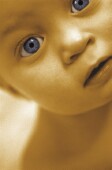
WEDNESDAY, Feb. 17 (HealthDay News) Infants who develop flat head syndrome may be more apt to experience delays in physical and mental development, a new study has found.
An infant can develop the syndrome, called positional plagiocephaly, by spending extended periods of time lying on a hard surface in one position. The condition can occur because an infant’s skull is still soft and malleable.
“For every 10 babies, one or two may have at least mild plagiocephaly,” Matthew L. Speltz, chief of outpatient psychiatric services at Seattle Children’s Hospital and professor of psychiatry and behavioral sciences at the University of Washington School of Medicine, said in a hospital news release.
“Many parents and physicians have dismissed it as a cosmetic issue or one that babies will grow out of as they develop, but our study indicates that we should look deeper,” Speltz said.
The study, which involved 472 babies, 4 months to 1 year old, found that those with flat head syndrome had lower scores on tests of cognitive and motor skills development. The tests included simple tasks that required the following: problem-solving and memory (such as searching for a hidden toy); the ability to imitate, vocalize, observe and respond to their environment; and motor skills such as crawling, rolling from side to side and being able to lift up from a tummy position.
The findings suggest an association between flat head syndrome and developmental delay, but they do not show a direct causal link. The researchers explained that there could be a reverse association: Infants with pre-existing motor skills delays could be more likely to develop flat head syndrome because they might move less or remain in one position for longer periods of time.
The findings, published online Feb. 15 in Pediatrics, indicate “that babies with flat head syndrome should be screened and monitored for possible cognitive and motor delays,” Speltz said.
“However,” he added, “it’s also important to note that our study examined babies at one particular point in time so we cannot say with certainty whether these observations continue to hold true as these infants grow older. Our future studies will revisit this population at 18 and 36 months of age to see whether this association persists as these infants mature.”
More information
The U.S. National Institute of Child Health and Human Development has more about positional plagiocephaly.

